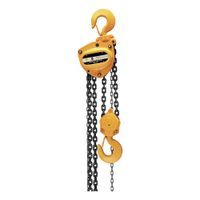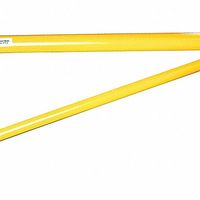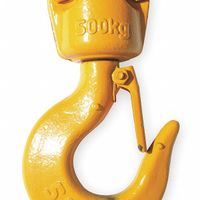Call +(254) 703 030 000 / 751 483 999 / 721 704 777
- Home
- Material Handling
- Lifting Pulling Positioning
- Hoists Trolleys
.....Read More
Frequently Asked Questions
What are the differences between electric, manual, and air hoists?
Electric hoists, manual hoists, and air hoists differ primarily in their power sources and operational mechanisms.
Electric hoists are powered by electricity and are designed for lifting heavy loads with minimal manual effort. They are equipped with electric motors that drive the lifting mechanism, making them suitable for frequent and heavy-duty lifting tasks. Electric hoists offer precise control, speed, and efficiency, and are commonly used in industrial settings where power supply is readily available. They can be operated via remote controls, enhancing safety and convenience.
Manual hoists, also known as chain blocks or hand chain hoists, rely on human effort to lift loads. They are operated by pulling a hand chain, which turns gears to lift the load. Manual hoists are ideal for lighter loads and situations where electricity is unavailable or impractical. They are portable, cost-effective, and require minimal maintenance, making them suitable for small workshops or temporary lifting tasks. However, they require more physical effort and are slower compared to electric hoists.
Air hoists, or pneumatic hoists, use compressed air as their power source. They are ideal for environments where electricity poses a risk, such as in explosive or flammable atmospheres. Air hoists offer smooth and precise control, similar to electric hoists, and are capable of continuous operation without overheating. They are often used in industries like mining, oil and gas, and chemical processing. However, they require a reliable compressed air supply and can be more expensive to operate and maintain compared to manual hoists.
In summary, the choice between electric, manual, and air hoists depends on factors like load capacity, frequency of use, available power sources, and specific environmental conditions.
How do I choose the right hoist for my application?
To choose the right hoist for your application, consider the following factors:
1. **Load Capacity**: Determine the maximum weight the hoist needs to lift. Choose a hoist with a capacity that exceeds this weight to ensure safety and efficiency.
2. **Lift Height**: Measure the vertical distance the hoist needs to lift the load. Ensure the hoist's lift height capability meets or exceeds this requirement.
3. **Power Source**: Decide between manual, electric, pneumatic, or hydraulic hoists based on available power sources and operational needs. Electric hoists are common for frequent use, while manual hoists are suitable for lighter, infrequent tasks.
4. **Duty Cycle**: Consider how often and how long the hoist will be used. A higher duty cycle is necessary for continuous or frequent operations.
5. **Environment**: Assess the working environment. For example, choose corrosion-resistant materials for outdoor or humid conditions, and explosion-proof hoists for hazardous areas.
6. **Speed**: Determine the required lifting speed. Faster speeds increase productivity but may require more power and control.
7. **Mounting Options**: Decide between fixed or portable hoists, and consider the type of mounting (e.g., hook, trolley, or base-mounted) based on your setup.
8. **Control Type**: Choose between pendant, wireless remote, or manual controls based on convenience and safety requirements.
9. **Safety Features**: Look for features like overload protection, emergency stop, and limit switches to enhance safety.
10. **Budget**: Balance cost with the required features and quality. Investing in a reliable hoist can reduce maintenance costs and downtime.
11. **Compliance**: Ensure the hoist meets industry standards and regulations for safety and performance.
By evaluating these factors, you can select a hoist that meets your specific application needs effectively and safely.
What are the safety precautions when using hoists and trolleys?
When using hoists and trolleys, several safety precautions are essential to ensure safe operation and prevent accidents:
1. **Inspection and Maintenance**: Regularly inspect hoists and trolleys for any signs of wear, damage, or malfunction. Ensure that all components, including hooks, chains, and cables, are in good condition. Perform routine maintenance as per the manufacturer's guidelines.
2. **Load Limits**: Always adhere to the rated load capacity of the hoist and trolley. Never exceed the maximum weight limit, as this can lead to equipment failure and accidents.
3. **Proper Training**: Operators should be adequately trained in the use of hoists and trolleys. They should understand the equipment's operation, safety features, and emergency procedures.
4. **Secure Load**: Ensure that the load is properly secured and balanced before lifting. Use appropriate slings, chains, or straps, and check that they are correctly attached to the load and hoist.
5. **Clear Pathway**: Keep the area around the hoist and trolley clear of obstructions. Ensure that the path of travel is free from obstacles and that there is sufficient clearance for the load.
6. **Use Safety Devices**: Utilize safety devices such as limit switches, emergency stop buttons, and overload protection to prevent accidents.
7. **Communication**: Maintain clear communication with all personnel involved in the lifting operation. Use hand signals or radios if necessary to coordinate movements.
8. **Avoid Side Pulling**: Do not use the hoist to pull a load sideways. This can cause the hoist to tip or the load to swing, leading to potential hazards.
9. **Stay Alert**: Operators should remain vigilant and focused during operation. Avoid distractions and ensure that all personnel are aware of the hoist's movements.
10. **Emergency Procedures**: Be familiar with emergency procedures in case of equipment failure or accidents. Ensure that all operators know how to safely lower a load in an emergency.
How do I maintain and repair hoists and trolleys?
To maintain and repair hoists and trolleys, follow these steps:
1. **Regular Inspection**: Conduct daily visual inspections for wear, damage, or misalignment. Check hooks, chains, ropes, and brakes for any signs of wear or deformation.
2. **Lubrication**: Regularly lubricate moving parts such as gears, bearings, and chains to reduce friction and prevent wear. Use manufacturer-recommended lubricants.
3. **Cleaning**: Keep the hoist and trolley clean from dust, dirt, and debris. Use a soft brush or cloth to clean components, ensuring no foreign particles affect operation.
4. **Load Testing**: Perform periodic load tests as per manufacturer guidelines to ensure the hoist can handle its rated capacity safely.
5. **Brake Inspection**: Regularly check the brake system for proper function. Adjust or replace worn brake components to ensure the hoist stops and holds loads securely.
6. **Chain and Rope Care**: Inspect chains and ropes for kinks, twists, or broken strands. Replace any damaged components immediately to prevent failure.
7. **Electrical Components**: For electric hoists, inspect wiring, switches, and controls for wear or damage. Ensure connections are secure and replace any frayed wires.
8. **Alignment and Tension**: Ensure the trolley is properly aligned on its track and that the hoist chain or rope is correctly tensioned to prevent uneven wear.
9. **Documentation**: Keep detailed records of all maintenance and repairs performed. This helps track the hoist’s condition and plan future maintenance.
10. **Professional Servicing**: Schedule regular professional inspections and servicing to address complex issues and ensure compliance with safety standards.
11. **Training**: Ensure operators are trained in proper use and basic maintenance to prevent misuse and identify potential issues early.
By following these steps, you can extend the lifespan of your hoists and trolleys and ensure safe operation.
What are the weight limits for different types of hoists?
The weight limits for hoists vary based on their type and design, catering to different lifting needs:
1. **Manual Chain Hoists**: Typically used for lighter loads, manual chain hoists can handle weights ranging from 0.5 tons (1,000 lbs) to 20 tons (40,000 lbs). They are ideal for environments where electricity is unavailable or for infrequent lifting tasks.
2. **Electric Chain Hoists**: These are more versatile and can lift heavier loads than manual hoists. Their capacity generally ranges from 0.25 tons (500 lbs) to 30 tons (60,000 lbs). They are suitable for industrial settings where frequent lifting is required.
3. **Electric Wire Rope Hoists**: Known for their ability to lift very heavy loads, electric wire rope hoists can handle weights from 1 ton (2,000 lbs) to over 100 tons (200,000 lbs). They are commonly used in construction, manufacturing, and heavy industry.
4. **Pneumatic (Air) Hoists**: These hoists are used in environments where electrical sparks could be hazardous. They typically have a capacity ranging from 0.5 tons (1,000 lbs) to 100 tons (200,000 lbs), depending on the model and application.
5. **Hydraulic Hoists**: Often used in specialized applications, hydraulic hoists can lift very heavy loads, with capacities ranging from 1 ton (2,000 lbs) to over 200 tons (400,000 lbs). They are used in industries like shipbuilding and heavy equipment manufacturing.
6. **Lever Hoists**: These portable hoists are used for lifting, pulling, and positioning loads. They generally have a capacity ranging from 0.25 tons (500 lbs) to 9 tons (18,000 lbs).
The specific weight limit for any hoist depends on its design, manufacturer specifications, and intended use. Always consult the manufacturer's guidelines to ensure safe operation within the hoist's rated capacity.
How do I install mounting brackets for hoists?
1. **Select Location**: Choose a sturdy location on a beam or ceiling that can support the hoist's weight and load.
2. **Gather Tools and Materials**: You will need a drill, appropriate drill bits, a wrench, a level, a measuring tape, and the mounting brackets.
3. **Measure and Mark**: Use the measuring tape to mark the exact spots where the brackets will be installed. Ensure the distance between the brackets matches the hoist's specifications.
4. **Drill Holes**: Use the drill and appropriate drill bit to create holes at the marked spots. Ensure the holes are straight and deep enough to accommodate the bolts.
5. **Install Brackets**: Position the mounting brackets over the drilled holes. Insert bolts through the bracket holes and into the drilled holes.
6. **Secure Brackets**: Use a wrench to tighten the bolts securely. Ensure the brackets are firmly attached and do not wobble.
7. **Level Check**: Use a level to ensure the brackets are even. Adjust if necessary by loosening and repositioning the brackets.
8. **Attach Hoist**: Once the brackets are secure and level, attach the hoist according to the manufacturer's instructions.
9. **Test Load**: Before full use, test the hoist with a light load to ensure stability and security.
10. **Safety Check**: Regularly inspect the brackets and hoist for any signs of wear or damage. Ensure all bolts remain tight.
Always follow the manufacturer's guidelines and safety standards during installation.
What are the common replacement components for hoists and trolleys?
Common replacement components for hoists and trolleys include:
1. **Wire Ropes and Chains**: These are critical for lifting and lowering loads. They can wear out due to friction, corrosion, or overloading.
2. **Hooks**: Subject to wear and deformation, hooks may need replacement to ensure secure load handling.
3. **Brakes**: Essential for controlling load movement, brakes can wear out over time and require replacement to maintain safety.
4. **Gears and Gearboxes**: These components can suffer from wear and tear, leading to inefficiencies or failures in operation.
5. **Motors**: Electric or hydraulic motors may need replacement due to burnout or mechanical failure.
6. **Control Systems**: Buttons, switches, and remote controls can fail due to frequent use or exposure to harsh environments.
7. **Bearings**: These components facilitate smooth movement and can wear out, leading to increased friction and potential failure.
8. **Limit Switches**: These are crucial for preventing over-travel of the hoist or trolley and can fail due to mechanical wear.
9. **Drums and Sheaves**: These components guide the wire rope or chain and can wear out, leading to improper operation.
10. **Load Blocks**: These may need replacement if they become damaged or worn, affecting load handling.
11. **Trolley Wheels**: Subject to wear, especially in high-use environments, and may need replacement to ensure smooth operation.
12. **Electrical Components**: Wiring, connectors, and fuses can degrade over time and require replacement to maintain electrical integrity.
13. **Safety Latches and Devices**: These components ensure safe operation and may need replacement if they become damaged or worn.
Regular maintenance and inspection are crucial to identify and replace these components before they lead to operational failures or safety hazards.





